Responsive Neurostimulator (RNS) Use in Patients With and Without Prior Vagus Nerve Stimulator (VNS) Implantation
Abstract number :
1.165
Submission category :
3. Neurophysiology / 3E. Brain Stimulation
Year :
2018
Submission ID :
497993
Source :
www.aesnet.org
Presentation date :
12/1/2018 6:00:00 PM
Published date :
Nov 5, 2018, 18:00 PM
Authors :
Cornelia Drees, University of Colorado; Stefan Sillau, University of Colorado; Danielle McDermott, University of Colorado; Aviva Abosch, University of Colorado; Steven Ojemann, University of Colorado; and Mesha-Gay Brown, University of Colorado
Rationale: A third of patients with epilepsy have drug-resistant seizures warranting epilepsy surgery. In the United States, surgical options include resections and neuromodulation, such as Vagus Nerve Stimulation (VNS) and Responsive NeuroStimulation (RNS). During RNS approval studies, pre-existing VNS was an exclusion criterion. Consequently, no data were acquired about efficacy or complications in patients with both devices. We present a retrospective chart review to investigate seizure outcome, complication rate and device interactions after RNS implantation in patients with and without previously-placed VNS. Methods: Our epilepsy surgery database was queried and any patient with RNS implantation was included (09/2015-12/2017). Patients with >6 months follow-up were analyzed regarding seizure outcome. Statistical analyses were performed with two-way tables, Fisher’s exact test, and logistic/relative risk regression (SAS 9.4). Results: 39 patients received a RNS and had a follow-up of >6 months (average 20 months [6-32]). Mean age (with and without VNS) was 38 years [range 19-63], 20 were male.Sixteen patients had a VNS implanted prior to RNS (VNS+), though in three patients it was deactivated. Between patients with and without VNS, age, mean duration of epilepsy (18.9 vs 16.7, p=0.53), and follow-up were comparable (Table). Mean latency from VNS to RNS placement was 7 years [range 2-13]. RNS addition was well-tolerated in 15 of 16 patients, but in one patient VNS had to be turned off 3 months after RNS placement because interrogation of both devices during a visit was associated with persistent VNS activation. Comparing RNS patients with and without VNS, seizure frequency at baseline was higher, but not significantly so, in patients with VNS (20.9 vs 10.9 without VNS, p=0.17), but it remained significantly higher in patients with VNS compared to without (5.3 vs 1.2 without VNS, p=0.0484).Adverse events related to RNS occurred in 6/39 patients (15.3%) and included hemiparesis, hemihypesthesia, intracerebral hemorrhage, and soft-tissue infection. Conclusions: In our RNS patients, pre-existing VNS was associated with a significant difference in seizure outcome, with VNS+ patients having a higher seizure rate at follow-up. The reasons for this are unclear, but could include negative device interactions, VNS prompting a resistance to RNS, or more resistant seizure networks. In one patient, persistent VNS stimulation after RNS implantation required its deactivation, but causality is undetermined. Future studies with bigger populations are needed to confirm these preliminary findings. Funding: None
